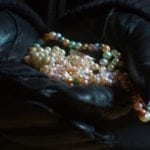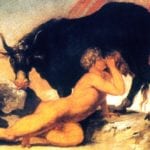 Politics
Politics  Politics
Politics  Weird Stuff
Weird Stuff Ten Bizarre Facts About The Doge Meme
 Our World
Our World 10 Ways Your Christmas Tree Is More Lit Than You Think
 Movies and TV
Movies and TV The 10 Coolest Stars to Set Sail on The Love Boat
 History
History 10 Things You Didn’t Know About the American National Anthem
 Technology
Technology Top 10 Everyday Tech Buzzwords That Hide a Darker Past
 Humans
Humans 10 Everyday Human Behaviors That Are Actually Survival Instincts
 Animals
Animals 10 Animals That Humiliated and Harmed Historical Leaders
 History
History 10 Most Influential Protests in Modern History
 Creepy
Creepy 10 More Representations of Death from Myth, Legend, and Folktale
 Politics
Politics 10 Political Scandals That Sent Crowds Into the Streets
 Weird Stuff
Weird Stuff Ten Bizarre Facts About The Doge Meme
 Our World
Our World 10 Ways Your Christmas Tree Is More Lit Than You Think
Who's Behind Listverse?

Jamie Frater
Head Editor
Jamie founded Listverse due to an insatiable desire to share fascinating, obscure, and bizarre facts. He has been a guest speaker on numerous national radio and television stations and is a five time published author.
More About Us Movies and TV
Movies and TV The 10 Coolest Stars to Set Sail on The Love Boat
 History
History 10 Things You Didn’t Know About the American National Anthem
 Technology
Technology Top 10 Everyday Tech Buzzwords That Hide a Darker Past
 Humans
Humans 10 Everyday Human Behaviors That Are Actually Survival Instincts
 Animals
Animals 10 Animals That Humiliated and Harmed Historical Leaders
 History
History 10 Most Influential Protests in Modern History
 Creepy
Creepy 10 More Representations of Death from Myth, Legend, and Folktale
10 Totally Weird Creature Adaptations
We’re all familiar with the scales and claws that some animals have evolved as adaptations. But other creatures have taken on traits so bizarre that the animals almost look like aliens. Watch science fiction come alive as we look at lizards that cry blood, worms that melt bone, and fish that shoot blades from their eyes.
10The Okapi’s Bizarre Tongue
The Okapi, native to remote African forests, resembles a horse with zebra stripes, but this elusive animal is actually a close relative of the giraffe. It’s usually found at elevations greater than 500 meters (1,640 ft), where its oily fur helps it stay dry in the constant drizzle.
The tongue of the okapi is prehensile and shaped like a tube, and it measures an impressive 30–36 centimeters (12–14 in). The muscular tongue mainly removes leaves from plants, but its length gives it another special ability: The okapi can lick its own eyeball, in order to clean it. It can also lick its own ear, though it’s unclear why it would want to.
9The Mouthless Bone-Melting Worm
Imagine throwing yourself upon a pile of food. It’s delicious, it’s tempting, but you can’t eat it because you have no mouth. But never fear: Instead of chewing and swallowing, you sweat acid onto the food. The solid food melts into broth, and you suck it in through your skin.
This is the daily routine of the osadex, otherwise known as the zombie worm. Its acid dissolves meat and even bone, and symbiotic bacteria allow the primitive animal to absorb the freed nutrients.
The mating system for this species is even weirder than its dietary habits. The males actually live inside the female—up to 100 tiny male worms live inside her at once, like a twisted reverse harem, living only to fertilize her.
8The Blood-Squirting Lizard
When disturbed, the greater short-horned lizard of North America shoots massive quantities of blood from its eye sockets. It makes for an exceptionally effective distraction and a grotesque escape scene. And the blood’s foul-tasting chemicals can send a predator running if any gets into its mouth.
This adaptation is easier on the lizard than shedding the tail, which is the other famously grisly lizard defense mechanism. Blood is a replenishable fluid rather than a distinct body part that must be grown back. But the lizard’s ability to defend itself with blood is still limited. Small lizards could easily bleed to death in a short time by losing too much blood.
7Cannibal Babies
Caecilians are among the strangest and most creepy amphibian species on the planet. They have barely visible eyes and no limbs, so they look much like worms. But they have hidden tentacles and teeth that kill prey. One species, Boulengerula taitanus of southeastern Kenya, is creepiest as a child, when its diet consists entirely of one thing: its mother’s skin.
During the breeding season, females produce thicker skin with higher nutrient levels. The juveniles pull the skin off and eat it with small teeth that resemble grappling hooks. The females show no distress at this behavior.
The young eventually grow up to feed on termites and other invertebrates.
6The Unearthly Hooded Seal
The blotchy gray hooded seal, native to the North Atlantic, seems normal enough—until it blows its nose.
The male seal already has one inflatable sac on its head—the hood that gives the animal its name—but when it chooses to, it can inflate a second one out of one nostril. The dark reddish balloon looks like it might pop as the seal brandishes it. The structure, like so many other male adornments, helps the seal attract mates.
5Loaches’ Eye Knives
Clown loaches, extremely popular as aquarium fish, are available in many pet stores. But careless fish keepers scooping up loaches may get a little more than they bargained for in the form of nasty cuts.
These relatives of carp and minnows are true martial arts masters. Below the eye sockets of loaches are razor-sharp spines that may be erected at will. Known as bifurcated subocular spines, these switchblade-like extensions emerge from grooves below the eye and slash into the flesh of animals targeting the loach’s head.
4The Twisted Wrybill
The wrybill is a thrush-sized plover native to New Zealand. Found in the winding, braided rivers of the South Island, this perfectly camouflaged shorebird has a distinction completely unknown in other bird species. Throwing away symmetry, this species has a bill permanently bent to the right.
You might be skeptical that a crooked beak offers any benefit at all. But the bend helps the bird reach food, letting it quickly fish invertebrates from under stones.
3The Raccoon Dog
Natural selection sometimes creates oddly similar forms from very different genetic stocks. A striking example of convergent evolution occurs in the dog family. The raccoon dog, as its name suggests, looks exceptionally like a raccoon, but it’s a genuine canine. Native to East Asia and introduced across Europe, the dog represents a primitive, ancestral type of canine and may illustrate how the dog family started out.
The raccoon dog’s weight and fur type fluctuate seasonally, with a maximum weight of only 9–10 kilograms (20–22 lb). Unusually for a canine, this creature can climb trees for food and shelter. The fur trade in parts of Asia threatens the welfare of these animals.
2Disgusting Vultures And Storks
Carrion-eating storks and vultures live in open, hot environments. As a result, they’ve developed an exceedingly strange cooling strategy. The birds will direct streams of urine and feces down both legs.
The evaporation cools the birds. The acidity also disinfects the bird’s leg, and scientists have observed that the material’s white residue reflects sunlight.
As though the vultures weren’t satisfied with bathing themselves in filth, they have an equally disgusting mechanism against enemies: defensive vomiting.
1The Basket Star’s Hidden Arms
Certain starfish, known as basket stars, grow to more than 60 centimeters (24 in) in diameter and extend long tendrils that act as traps.
When the starfish spots some zooplankton, it wraps the tendrils around the prey and secretes mucus to trap it. Then it draws the food to its mouth, feeds on it, and extends the tendrils again to catch its next victim.
Ron Harlan is a student of science and avid explorer of planet Earth. He is a freelance writer, avid naturalist, and graduate student of science in British Columbia. His wild bird tours are available in BC. Send inquiries to receive your online information package!








